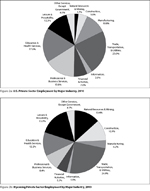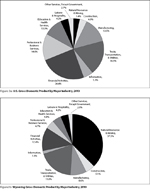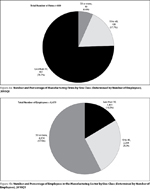Training for What? Part 1
Manufacturing Industry in Wyoming Small but Growing
The next several issues of Wyoming Labor Force Trends will contain articles analyzing Wyoming's manufacturing industry. The articles in this issue examine the manufacturing industry as a whole, and compare new hires in this industry to occupational projections and current staffing patterns (see related article). The July issue will include articles on training needs in the manufacturing industry and skills considerations for new hires.
The last several years have been tumultuous in Wyoming and the nation. The Great Recession in the United States lasted from December 2007 to June 2009 (NBER, 2010), and although the economy has grown, the growth has proven relatively slow and has not led to substantial gains in employment. Employment in the overall private sector and in the manufacturing sector continued to fall until September 2010 both nationally and in Wyoming (see Figure 1).This article compares and contrasts Wyoming's industry composition to that of the United States as a whole, with a focus on the manufacturing industry.
Employment in the overall private sector and in the manufacturing sector continued to fall until September 2010 both nationally and in Wyoming (see Figure 1).This article compares and contrasts Wyoming's industry composition to that of the United States as a whole, with a focus on the manufacturing industry.
What is Manufacturing?
Some firms that are found in the manufacturing industry may be surprising.
For example, many firms involved in agricultural processing are included in the manufacturing industry, as opposed to the agriculture industry, such as breweries and cane sugar refining.
The Bureau of Labor Statistics defines the manufacturing industry in this way:
The manufacturing sector comprises establishments engaged in the mechanical, physical, or chemical transformation of materials, substances, or components into new products.
Establishments in the manufacturing sector are often described as plants, factories, or mills and characteristically use power-driven machines and materials-handling equipment. However, establishments that transform materials or substances into new products by hand or in the worker's home and those engaged in selling to the general public products made on the same premises from which they are sold, such as bakeries, candy stores, and custom tailors, may also be included in this sector. Manufacturing establishments may process materials or may contract with other establishments to process their materials for them. Both types of establishments are included in manufacturing.
Many discussions regarding the U.S. economy revolve around the perceived loss of the U.S. manufacturing base and employment. While this is true over the 10 years from 2001 to 2010, employment in the manufacturing industry has been increasing in early 2011 (BLS, 2011; see Figure 1). In 2009, the U.S. led the world with $1.7 trillion in value-added manufacturing, followed by China ($1.3 trillion). Additionally, the U.S. manufacturing industry was larger than Japan and Germany's combined (Keefe, 2011).
The composition of employment and economic output in Wyoming's major industries deviates substantially from the national profile in  some cases and closely matches it in others. Figures 2a and 2b compare the U.S. and Wyoming by the proportion of employment by major industry in 2010. In both cases, trade, transportation, & utilities is the largest employment sector, at 23.0% for the U.S. and 24.0% for Wyoming. Retail trade is included in this sector and comprises a significant portion of employment in the economy.
some cases and closely matches it in others. Figures 2a and 2b compare the U.S. and Wyoming by the proportion of employment by major industry in 2010. In both cases, trade, transportation, & utilities is the largest employment sector, at 23.0% for the U.S. and 24.0% for Wyoming. Retail trade is included in this sector and comprises a significant portion of employment in the economy.
The largest difference between the U.S. and Wyoming economies is in the natural resources & mining sector, which provides 13.4% of the employment in Wyoming, but only 1.7% nationwide. The proportion of jobs found in the professional & business services sector in Wyoming is roughly half the national share (8.4% to 15.8%). Manufacturing provides 10.8% of the employment nationally, but only 4.2% in Wyoming.
In terms of economic output, the financial activities sector is the largest contributor to Gross Domestic Product (GDP) nationally at 24.4%, followed by trade, transportation, & utilities at 18.5% (see Figure 3a). Manufacturing contributes  13.5% of economic output nationally.
13.5% of economic output nationally.
In Wyoming, the natural resources & mining sector contributes the most to the state GDP by far at 37.5%, compared to just 3.4% nationally (see Figure 3b). The trade, transportation, & utilities sector accounts for roughly the same amount of economic activity in Wyoming (19.0%) and nationally (18.5%). Manufacturing accounts for 8.6% of Wyoming's economic output.
In 2009 and 2010, manufacturing accounted for a higher percentage of Wyoming employment than at any other point over the last decade; this increase may indicate that manufacturing is becoming a more important  component of the state's economy.
component of the state's economy.
There were 609 establishments and 8,479 employees within the manufacturing industry in Wyoming for first quarter 2010, and 75.7% of the firms were composed of fewer than 10 employees (see Figure 4a). While these smaller establishments comprise the bulk of manufacturing firms, they only provide 16.5% of the manufacturing employment (see Figure 4b). Firms with 50 or more employees provide the majority of the manufacturing employment (57.5%), despite only accounting for 6.6% of the total manufacturing firms.
References
Keefe, J. (2011, June 21). Manufacturing surprise: the U.S. still leads in making things. CBSmoneywatch.com. Retrieved June 29, 2011, from http://moneywatch.bnet.com/economic-news/blog/macro-view/manufacturing-surprise-the-us-still-leads-in-making-things/2134/
National Bureau of Economic Research. (2010). Retrieved July 7, 2011, from http://www.nber.org/cycles/sept2010.html
U.S. Bureau of Labor Statistics. (2011). Current Employment Statistics. Retrieved July 13, 2011, from http://www.bls.gov/ces/
